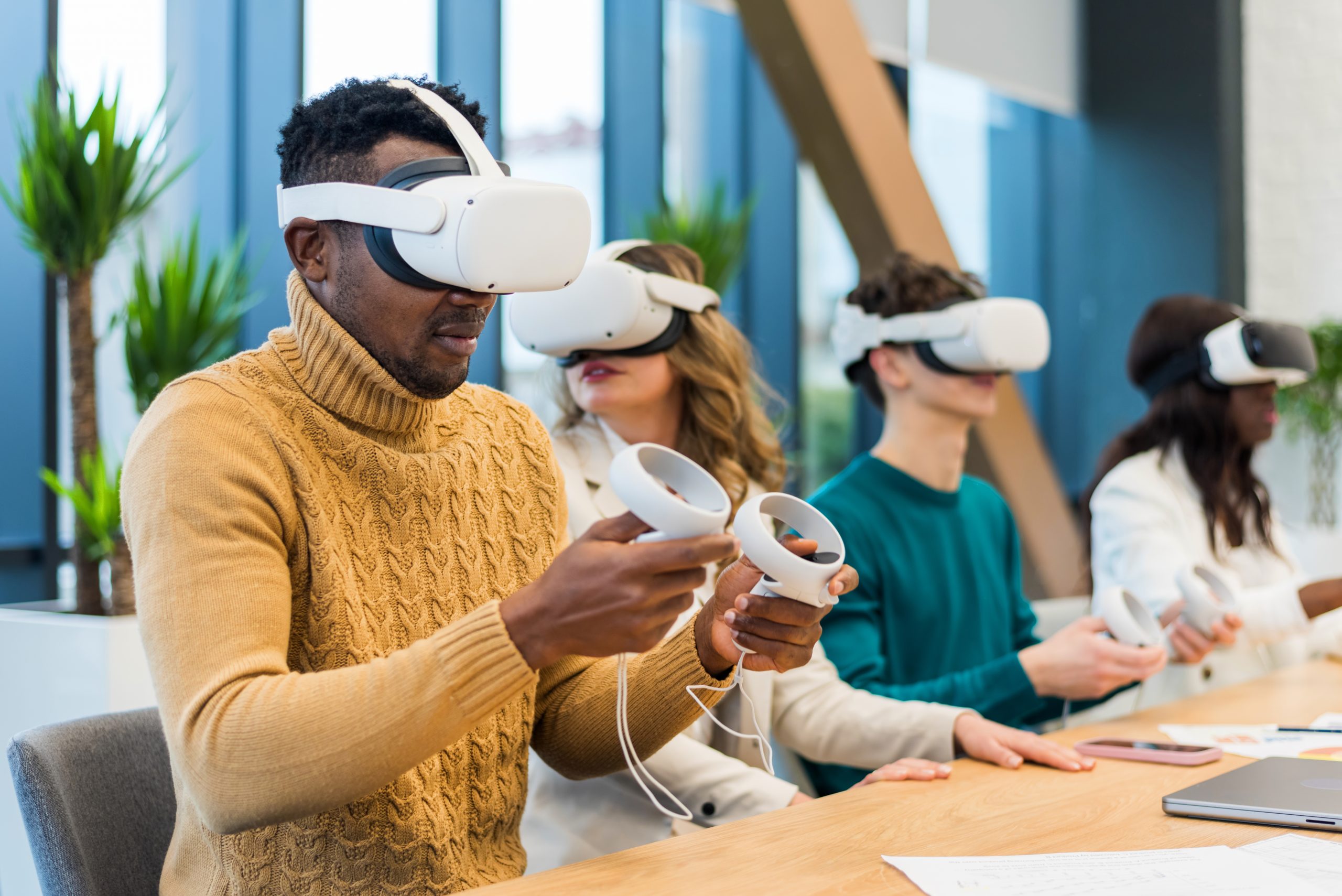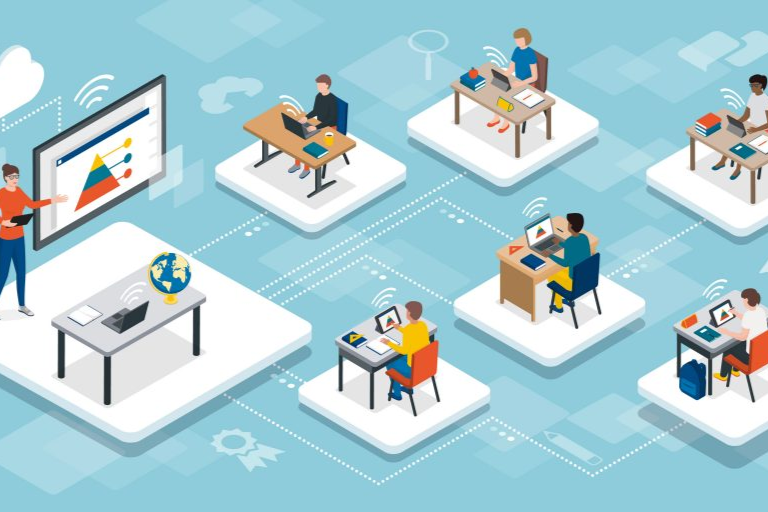
Image by Frimufilms from Freepik
12 principles for effectively using learning technologies
Adopted from Dr. Tony Bates’s “12 GoldenPrinicples for effectively using learning technologies” and modified by JJ Cloutier
Content review October 2023
- About Dr. Tony Bates
- Principle 1: Good teaching
- Principle 2: Aesthetic
- Principle 3: Flexible
- Principle 4: Benefits and limitations
- Principle 5: Multiple media
- Principle 6: Interaction
- Principle 7: Student numbers
- Principle 8: New is not better
- Principle 9: Teaching is a discipline
- Principle 10: Change with technology
- Principle 11: Teamwork
- Principle 12: Designing the experience
- Help for designing your course experience.
About Dr. Tony Bates
Dr. Tony Bates is the author of eleven online learning and distance education books. He has provided consulting services specializing in training in the planning and managing of online learning and distance education, working with over 40 organizations in 25 countries. Tony is a Research Associate with Contact North | Contact Nord, Ontario’s Distance Education & Training Network and ‘sibling’ organization to the Manitoba Flexible Learning Hub.
For over 50 years, Bates has been researching the effectiveness of learning technologies and gradually has come to define a set of 12 key principles in their use that have outlasted the many technological changes in the educational field.
Principle 1: Good teaching
Clear objectives, good structuring of learning materials, relevance to learners’ needs, etc., apply to
the use of any technology for teaching, and if these principles are ignored, then the teaching will fail,
even if the unique characteristics of the medium are stylishly exploited.
We have seen too many bad uses of technology for teaching and learning, not because the technology was poor, didn’t work, or was even inappropriate, but because the teaching method did not produce good learning outcomes (emergency remote learning, anyone?). We have also seen brilliant teachers wrestle with inappropriate technology to produce good results.
Principle 2: Aesthetic
Professional production and design are essential. Each medium has a different range of production skills
necessary to exploit its unique features; this means that ‘quality’ production counts.
There are professional ways to make, for instance, videos, film or television, that follow widely accepted principles (such as lighting, editing, and structure).
Technically, high standards are much easier to achieve today than 30 years ago. A well-lit, cleanly edited video is likely to be more educationally effective than a poorly shot and poorly edited video, but it is much easier for an instructor working on their own to achieve this than it was 30 years ago. The same applies to text. Clear, well-constructed writing is always more educationally effective than writing with poor grammar, heavy use of jargon, and unclear structure—quality in production matters.
Principle 3: Flexible
Technologies are generally flexible and, hence, interchangeable in education and training. Given sufficient imagination, time and resources, what can be achieved educationally through one technology can usually be achieved through another technology. Thus, the absence or non-availability of a particular technology does not necessarily prevent learning goals from being achieved.
Technologies can often be easily substituted in teaching and still achieve the same results as emergency remote learning.
Principle 4: Benefits and limitations
New or different learning outcomes can be achieved if the possibilities of a specific technology are fully
exploited, allowing for the transformation of teaching.
Looking for the differences, rather than the similarities, between different media can help in deciding between, for instance, in-person or online learning or between synchronous and asynchronous use of technology. What, for instance, are you doing in your classroom teaching that could not be done just as well online? What is the extra benefit of a synchronous lecture over a recorded or asynchronous lecture – and vice versa? Ensure you try to fully exploit the medium’s possibilities rather than using the most convenient tool.
This leads to my law of equal substitution: everything can be taught as well online as face-to-face, except….It is the ‘exceptions’ we should focus on.
Principle 5: Multiple media
There are many media today, including audio, video, computing, and face-to-face teaching. Research has clearly shown that learners learn better from multiple media types.
We make a distinction between technology and media.
Technologies in education are things or tools used to support teaching and learning. A printing press is a technology. Thus, computers, software programs such as a learning management system (LMS), and a transmission or communications network are all technologies. Technology often includes a combination of tools with particular technical links that enable them to work as a technology system, such as the telephone network or the Internet.
However, technologies or even technological systems do not communicate or create meaning. They sit there until commanded to do something or until they are activated.
Media require active content creation or communication and someone who receives and
understands the communication and the technologies that carry the medium. The leading media-using technologies are text, video, audio and computing.
An advantage of thinking about media rather than technology is that we can consider face-to-face or in-person teaching as a medium. Its technology is the physical classroom. Online learning is another medium using a variety of technologies.
However, the greater the number of technologies used, the more complex the design process, and the greater the chance of redundancy and wasted expenditure; the aim, therefore, should be to use a limited range of technologies in any given context but covering all the main media.
This principle could be re-phrased to keep it simple. Although multiple media are more effective than a single medium, you can overdo it. Most instructors do not have the time to exploit every single medium available, and students can easily get confused.
Focusing on the key strengths and limitations of different media helps to limit the choice and may result in using a technology that can carry several media. One advantage of the Internet is that it seamlessly integrates several media, such as text, audio, video and computing.
Principle 6: Interaction
High-quality interaction with learning materials and interaction between teachers and other learners is
essential for effective learning.
All the research suggests that students, especially online students working in isolation, must be active learners. They need to interact with the instructor, other students, and the learning materials. The technology must enable this. This has been reinforced by theories such as Garrison, Anderson and Archer’s Community of Inquiry. Research has shown that interpersonal communication can be provided as effectively at a distance, through appropriate technologies, as through face-to-face contact, but it must be deliberately designed into a course. Engagement at a distance has to be intentionally fostered, as you can’t assume the spontaneous interaction that can arise in face-to-face teaching.
Principle 7: Student numbers
The total number of students to be served over the life of a course is a critical factor in technology selection.
Some technologies are much more economical than others with large numbers; with others, costs increase proportionately with student numbers.
This probably needs to be balanced with Principle 6, in that no matter the student numbers, effective interaction remains critical for successful learning. As student numbers increase, so do the costs of interaction generally. This has been a big challenge for Massive Open Online Course (MOOC) providers such as Coursera and EdX, and there is an interest in artificial intelligence (AI), such as chatbots, to manage interaction with large numbers of students.
Nevertheless, many institutions developed cost-effective online programs using a seven-year horizon or more, as development costs can be shared across different cohorts. Therefore, the marginal costs of online learning can be lower than for in-person teaching. In particular, technology can provide better alternatives to large lecture classes with the right design. Take the long view; what may appear more costly in the first year may be less expensive over eight years – and vice versa.
Principle 8: New is not better
No law says new technologies are automatically better for teaching than old ones. Our judgment about new technologies should be made on educational and operational criteria, not by date stamp. Many of the lessons learned from the application of ‘older’ technologies still apply to any
newer technology.
The Gartner hype cycle suggests it is a bit more complex than this. New technologies get over-hyped but settle down to find their educational niche as their functionalities and benefits become better understood. No ‘killer’ technology will wipe out all others – not even AI, we suspect.
Principle 9: Teaching is a discipline
We need to apply the principles of learning science through the training of instructors, but first, the
science has to be understood and accepted by instructors.
Unfortunately, some instructors in post-secondary education are unaware of or ignore such learning science. Teachers need training to use technologies effectively, not just in choosing and using appropriate technologies, but more fundamentally in how people learn and in instructional design. Lack of appropriate training is the most significant barrier to the effective use of technology in education.
However, the formal training of instructors is not the only way to apply this knowledge. Working in teams or providing on-demand access to training resources as needed can also be effective.
Principle 10: Change with technology
It is no good merely replacing or adding technology to an existing method of teaching. This fails to exploit the functionalities and benefits of the medium. A good theory of teaching and learning and an understanding of the functionalities and benefits of the technology can help transform the teaching method.
This is based on a historical understanding of how technological innovation generally works. Henry Ford had to transform the manufacturing process to make cars affordable. Movies started as films of vaudeville theatre until they were transformed by the techniques of The Birth of a Nation, which used location shooting and staged battles. Moving lectures online during the COVID-19 pandemic for emergency remote learning was a classic example of failing to change the teaching process to meet the demands of learners studying in isolation.
Principle 11: Teamwork
Teamwork leads to higher quality in the use of educational technologies. No one can know
everything there is to know about the educational use and design of every technology now available and be a subject expert. Subject experts, media specialists and instructional designers are essential for effectively using technology in teaching.
Although teamwork is important, there is now a scaling issue. Teamwork is possible when less than 10 percent of all teaching is technology-based. With the rapid increase in blended learning, nearly all instructors need to know how best to use technology in their teaching. Providing a team for every instructor is economically not feasible unless the number of students is sufficient to justify a team approach.
We need to find cost-effective alternatives so instructors have more ability to make their own decisions on effective technology use, especially for smaller classes. This means we need to make greater use of ‘just-in-time’ and open resources for instructors on specific uses of technology for teaching, such as how to make a compelling video or design a serious game.
Principle 12: Designing the experience
Enough technology is around now to allow you to teach however you choose. The issue is: How and what do you want students to learn? And where?
The effectiveness of technology-based open learning is now a non-issue. Concentrate on designing the learning experience and not on testing the technology.
Technology is not the issue. Teaching methods that effectively exploit the functionalities and benefits of
different media is the issue. While trial and practice lead to better results, it is a slow process with many mistakes along the way. We must apply what is already known and researched about using technology for teaching.
Applying these 12 principles is a start.
This document was developed by Dr. Tony Bates, 12 Golden Principles for Effectively Using Learning Technologies, teachonline.ca by Contact North|Nord
This document is reproduced and modified slightly from the original publication under the terms of the Creative Commons License, Attribution-ShareAlike 4.0.
Help for designing your course experience.

Are you seeking help with any of the topics above, course design, interaction in your course, or incorporating multiple media sources? We have staff you can consult with for your flexible learning (online, blended or distributed) courses.
Book a one-on-one instructional design consultation with our Instructional designer for help with your course design.
You may also be interested in


Developing online learning activities for blended or distributed learning courses


